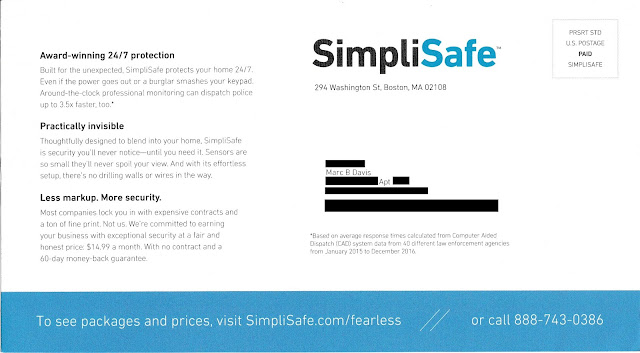After his friends were robbed, Chad Laurans discovered a serious problem in the home security industry. No one was protecting renters. Alarm systems needed a ton of hardwiring and came with pricey long-term contracts that couldn’t be canceled. So Chad built something new.This story about Chad Laurans's inspiration is quoted from SimpliSafe's page focused on apartments, located here. The same page includes a sales message referencing apartment protection:
Now SimpliSafe is the fastest growing home security company in the nation. SimpliSafe won’t lock you in a long-term contract and 24/7 professional monitoring is only $14.99 a month. Protect your apartment—the smart way.So it would appear that Mr. Laurans understands the needs of people who live in apartments for adequate security. That brings us to a postcard mailed to apartment homes and what I believe is a Fail for Targeting and Creative.
 |
| Lead Generation Postcard |
I live in a co-op apartment building, which typically consists of units that resemble apartments. Although they are cooperatively owned (rather than rented out) by their residents, these are very similar to rental apartment units in that they are underserved by the legacy home security companies.
 |
| Lead Generation Postcard - Address Side |
On their website, if one clicks on "Shop Now" either from the home page or the /fearless landing page mentioned on the postcard, the lead product is the most expensive one. Even the "Shop
Now" link found on the apartment-focused page leads to several product bundles starting with The Haven for $489 that includes 14 pieces of security equipment including a freeze sensor.
Presuming this postcard is part of a national campaign, a version should have been created specifically for people living in apartments.* The apartment-versioned postcard could support Mr. Laurans’s story by mentioning the need for even small apartments to have physical protection. In addition to communicating a low monthly price, the postcard could focus its limited space to communicating safety, peace of mind, renters insurance discounts, and effortless set-up. The Call to Action would be to a visit a landing page that reinforces service benefits while leading with a product package best suited for apartments. This could be The Foundation, The Essentials, or a similar lower-priced package. After all, many renters don't need water or freeze sensors.
 |
| Apartment-centric page - mobile view |
SimpliSafe may also want to consider the entire prospect user experience that results from using the postcard as a lead generation device. Above, for example is the Apartment-centric page as viewed on a Pixel 3a XL. Much of the type is too small to read on a mobile device. Other pages in the domain require a reader to scroll left and right — cumbersome on a laptop and an outright hassle on a mobile phone. Mobile use as a percentage of internet traffic continues to increase, even for people in their homes, and especially for young renters. SimpliSafe should consider creating mobile-friendly versions of their site or fully embrace responsive design.
If SimpliSafe's communications are optimized for target market relevancy, this company's story could have a happy ending. To paraphrase a SimpliSafe tagline, that would be "Direct Marketing. Done Right."
| SimpliSafe Retargeting Ad - laptop view |
Lessons:
- When your product has multiple target markets, segment your list selection and messaging to appeal to those target markets.
- Maintain messaging consistency and product recommendations relevant to your target market segment all the way through an online sale.
- Consider how your content appears on mobile devices.
*It could be that SimpliSafe is segmenting rental-style apartments in their list selection, and I received a piece designed for single-family homes because I live in an owner-occupied unit. Nonetheless, the presence of an apartment number in my address should have been a flag for list scrubbing, segmentation, or at least understanding the nature of co-op apartments.




















